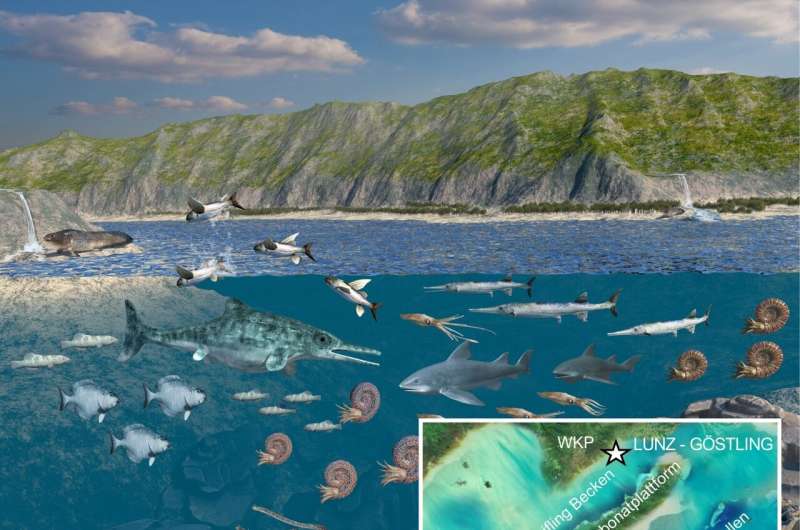This article has been reviewed according to Science X's editorial process and policies. Editors have highlighted the following attributes while ensuring the content's credibility:
fact-checked
peer-reviewed publication
proofread
On the trail of global climate change—volcanism as a driver of the climate in the 'Carnian Crisis'

New research on the so-called Carnian Crisis by a team led by Alexander Lukeneder, paleontologist at the Natural History Museum Vienna, reveals astonishing developments surrounding global climate change during the Triassic period.
Extensive geochemical and geophysical data help decipher one of the greatest environmental catastrophes in Earth's history, the Carnian Crisis. Climate change 233 million years ago led to a global mass extinction in the seas of the Mesozoic era. The results have now been published for the first time in Scientific Reports.
The global Carnian Crisis lasted 2 million years (234–232 million years), the effects of which have been preserved in the rocks of the Reiflinger Basin in the vicinity of Lunz am See. Massive volcanism in Canada and the northern U.S. led to the deposition of a layer of basalt more than a thousand meters thick. The resulting enormous CO2 emissions into the atmosphere changed the climate.
The late Triassic period was characterized by a greenhouse climate with monsoon-like rainfall, which led to increased mud input into the Tethys Ocean. The reefs suffocated, carbonate platforms died off and oxygen became scarce on the sea floor, forming dead zones.
Preserve deposits with particularly good preservation of the embedded fossils could develop under these conditions. In addition to ammonites, squid, mussels, snails, crabs, sea isopods and bristle worms, you can also discover unusually well-preserved and extremely rare fossils such as flying fish, the coelacanth Coelocanthus or the lungfish Tellerodus.
The sea of the Reiflinger Basin was surrounded by the first groups of islands, on which the first forests of conifers such as Voltzia formed under humid and warm conditions. The proximity to fresh water is also confirmed by alluvial remains of various land plants and finds of numerous leaf-footed crustaceans of the genus Euestheria.
The phase known as the Carnian Crisis can only be observed in a narrow geological zone in Austria. It extends from Mödling in Lower Austria in the east to northern Styria near Großreifling, i.e., into the area of the Styrian Eisenwurzen Nature and UNESCO Geopark in the west.
The great diversity of the fauna discovered in the preserved deposits around Lunz am See and the fantastic preservation make it possible to investigate the environment of the late Triassic period and gain new insights into environmental conditions, food chains and the predator-prey relationships of this time.
Starting with tiny crustaceans, the food chain extended through smaller fish to predatory squid and ammonites, which in turn were preyed upon by larger predatory fish. Ichthyosaurs were the top predators of this ecosystem in the Late Triassic Reiflinger Basin.
Modern research
An international team led by Alexander Lukeneder from the NHM Vienna, Petra Lukeneder (University of Vienna), Reinhard Sachsenhofer (University of Leoben), Manuel Rigo (University of Padua) and Guido Roghi (National Research Council of Padua) have been researching one of the biggest environmental catastrophes in the history of the Earth.
A wide range of investigations have been carried out on rocks and fossils and the latest methods of analysis have been applied. Macrofossils such as ammonites, squid and fish were analyzed, as well as representatives of the flora. In addition, the pollen associations and their changes over the duration of the Carnian crisis were analyzed.
A change from purely marine conditions to freshwater-influenced conditions with an increased occurrence of floodplains and marshland with pioneer vegetation can be seen.
Based on microfossils and geochemical and geophysical analyses, a detailed picture of the environment 233 million years ago in the Austrian Limestone Alps has emerged. The revised identification of ammonites and the analysis of tiny fish teeth allow a precise age classification.
The rock sequences in the Austrian Limestone Alps are comparable with deposits of the same age in the entire Tethys region. The strong input of CO2 through volcanism changed the global composition of carbon isotopes. This chemical trace of the global greenhouse climate can also be detected in the rocks near Lunz am See.
Geophysical measurements on the different rocks clearly show an increase in radiating particles and magnetizable minerals during the Carnian Crisis as well as a change in the composition of clay minerals. The higher proportion of these particles indicates an increased input of weathering products and organic residues of land plants from the surrounding land into the sea basin due to increased precipitation.
Biomarkers—chemical substances in the sediment that originate from former organisms—indicate that during this wetter phase, the organic matter was increasingly derived from land plants, i.e., it was washed into the Reiflinger Basin. The environmental conditions changed. This part of the Tethys Ocean was cut off and oxygen-poor, hostile conditions spread to the sea floor. The material washed in from the land permanently changed the water chemistry.
Geologists had long noticed the succession of lighter Reiflinger limestones to dark Göstlinger limestones, which were eventually overlaid by finely laminated Reingraben layers. This change can now be explained by the changing climatic conditions.
The finely laminated Reingraben layers with their unusual wealth of fossils were formed during the height of the Carnian Crisis. There were no scavengers in the oxygen-free mud to eat the dead organisms. Life was no longer possible on the sea floor and in the sediment.
More information: Alexander Lukeneder et al, Multi-proxy record of the Austrian Upper Triassic Polzberg Konservat-Lagerstätte in light of the Carnian Pluvial Episode, Scientific Reports (2024). DOI: 10.1038/s41598-024-60591-9
Journal information: Scientific Reports
Provided by Naturhistorisches Museum Wien





















